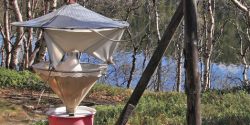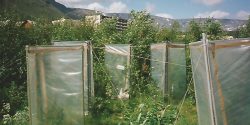Past research
My team previously used four approaches to quantify the effects of climate change on insect-plant interactions. First, we analysed the results of long-term monitoring (lasting 22–32 years) of forest moths, leaf beetles and insect herbivory conducted in subarctic regions of Finland and Russia. Second, we used latitudinal gradients and urban areas in Northern Europe as natural laboratories to infer responses of background insect herbivory to temperature (see also Macroecology) . Third, we used passive greenhouse chambers to study the impacts of elevated temperatures on insect-plant interactions under field conditions. Fourth, we employed meta-analysis to infer general patterns in the effects of experimental elevation of both CO2 and temperature on plant-feeding insects and their host plants, and we used published (historical) data to identify past changes in background losses of woody plant foliage to insects.
Ongoing research
We are currently processing the data on the belowground herbivory collected along a latitudinal gradient in Northern Europe and on the effects of ambient temperatures on the feeding niche breadth and adult behaviour of the polymorphic leaf beetle, Chrysomela lapponica. We also collect data for a meta-analysis of the effects of abiotic drivers of global change on fine root production and on root quality as a resource for root-feeding insects.
Featured publications
Zvereva, E. L., Hunter, M. D., Zverev, V., Kruglova O., & Kozlov, M. V. (2019) Climate warming leads to decline in frequencies of melanic individuals in subarctic leaf beetle populations. The Science of the Total Environment, 673, 237‒244 (doi: 10.1016/j.scitotenv.2019.03.458).
We observed strong decline in the proportion of dark (melanic) morphs in the populations of the leaf beetle, Chrysomela lapponica, across multiple sites in the Kola Peninsula (northwestern Russia) from 1992 to 2018. Using model selection procedures, we associated this decline with increases in minimum spring (May–June) daily temperatures. These results suggest that the two-fold decline in dark morph frequencies during the past 26 years has been driven by the simultaneous 2.5 °C increase in spring temperatures, most likely because dark males lose mating advantages that they obtain over light males during cold springs.
Kozlov, M. V., Lanta, V., Zverev, V., Rainio, K., Kunavin, M. A. & Zvereva, E. L. (2017) Decreased losses of woody plant foliage to insects in large urban areas are explained by bird predation. Global Change Biology, 23, 4354‒4364 (doi: 10.1111/gcb.13692).
We found that the foliage losses to insects in 16 European cities were on average 16.5% lower than in neighbouring rural habitats. This effect was significant in large cities (city population 1–5 million) but not significant in medium-sized and small towns. The insect mortality due to ants and birds and the bird attack intensity on dummy larvae were higher in large cities than in rural habitats, which explained the decline in insect herbivory with increase in urbanization.
Kozlov, M. V., Zverev, V. & Zvereva, E. L. (2017) Combined effects of environmental disturbance and climate warming on insect herbivory in mountain birch in subarctic forests: results of 26-year monitoring. The Science of the Total Environment, 601‒602, 802‒811 (doi: 10.1016/j.scitotenv.2017.05.230).
The leaf-eating insects in subarctic forests around the nickel–copper smelter at Monchegorsk, north-western Russia, demonstrated variable, and sometimes opposite, responses to pollution and to climate variations. We found that insect herbivory did not depend on the level of pollution, and that damage to birch leaves by insects decreased during the observation period in heavily disturbed forests, did not change in moderately disturbed forests and tended to increase in pristine forests. This diversity of responses, in combination with the decreased stability of insect–plant interactions, increases the uncertainty in predictions on the impacts of global change on forest damage by insects.
Kozlov, M. V. & Zvereva, E. L. (2015). Changes in the background losses of woody plant foliage to insects during the past 60 years: are the predictions fulfilled? Biology Letters, 11, 20150480 (doi: 10.1098/rsbl.2015.0480).
The prevailing scenarios predict that herbivory will increase with climate warming. However, analysis of the published data on the background foliar losses of woody plants to insects in natural ecosystems across the globe from 1952 to 2013 provided no support for this hypothesis. We detected no temporal trend in herbivory within the temperate climate zone and a significant decrease in herbivory in the tropics.
Zvereva, E. L., Hunter, M. D., Zverev, V. & Kozlov, M. V. (2016) Factors affecting population dynamics of leaf beetles in a subarctic region: the interplay between climate warming and pollution decline. Science of the Total Environment 566-567, 1277–1288 (doi: 10.1016/j.scitotenv.2016.05.187).
We explored how simultaneous changes in climate and pollution affect population dynamics of plant-feeding insects. In spite of 3 °C warming from 1993 to 2014, we did not observe an increase in abundance in any of four monitored leaf beetle species. Moreover, densities of two species declined 20-fold with fivefold decrease in emissions due to increase in mortality from natural enemies. This pattern suggests that at least in some tri-trophic systems, top-down factors override bottom-up effects and govern the impacts of environmental changes on insect herbivores.
Kozlov, M. V., Stekolshchikov, A. V., Söderman, G., Labina, E. S., Zverev, V. & Zvereva, E. L. (2015) Sap-feeding insects on forest trees along latitudinal gradients in northern Europe: a climate-driven pattern. Global Change Biology, 21, 106–116 (doi: 10.1111/gcb.12682).
We developed and employed the new method to evaluate background losses of forest trees to sap-feeding insects and found that in boreal forests these losses are of the same order of magnitude as losses to defoliators. Plant losses to sap-feeders demonstrated hump-shaped relationships with mid-summer temperatures, indicating that climate warming may have different consequences for background insect herbivory in different climate zones.
Hunter, M. D., Kozlov, M. V., Itämies, J., Pulliainen, E., Bäck, J., Kyrö, E.-M. & Niemelä, P. (2014) Current temporal trends in moth abundance are counter to predicted effects of climate change in an assemblage of subarctic forest moths. Global Change Biology, 20, 1723-1737 (doi: 10.1111/gcb.12529).
We examined population dynamics of subarctic forest moths in Finnish Lapland based on light trapping that was made continuously over a period of 32 years. Temperature and winter precipitation at our study site increased rapidly during the sampling period. The per capita rates of change of moth species’ abundance were more frequently associated negatively than positively with climate change variables. Nonetheless, subarctic forest moths are performing better than expected, suggesting that their populations are buffered at present from potential deleterious effects of climate change by other ecological forces.
Co-authors
†N. Berlina
J. Bäck
T. Callaghan
M. D. Hunter
I. Hajdamowicz
I. Itämies
J. Kanervo
S. Koponen
J. Kouki
E.-M. Kyrö
E. Labina
M. Lewandowski
P. Niemelä
E. J. van Nieukerken
P. W. Price
E. Pulliainen
A. Skoracka
M. Stańska
G. Söderman
A. Stekolshchikov
A. Wolf
E. Zvereva
V. Zverev
Co-operating scientists
V. Barcan
A. Selikhovkin
B. Smith
V. Zhirov
Funding
Academy of Finland
University of Turku
European Commission (FP4 and FP6)

